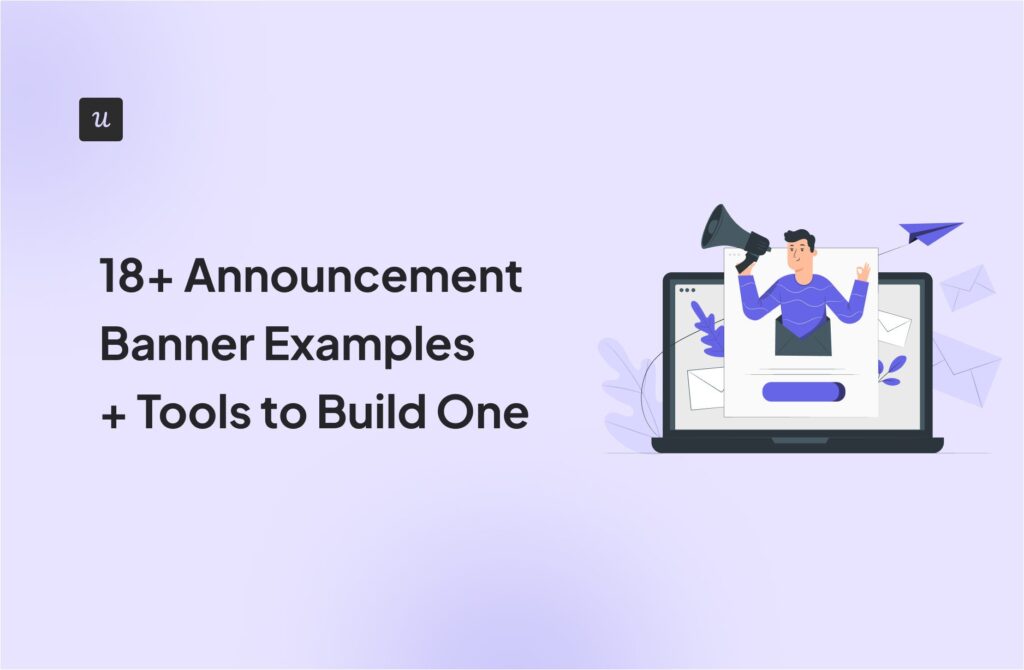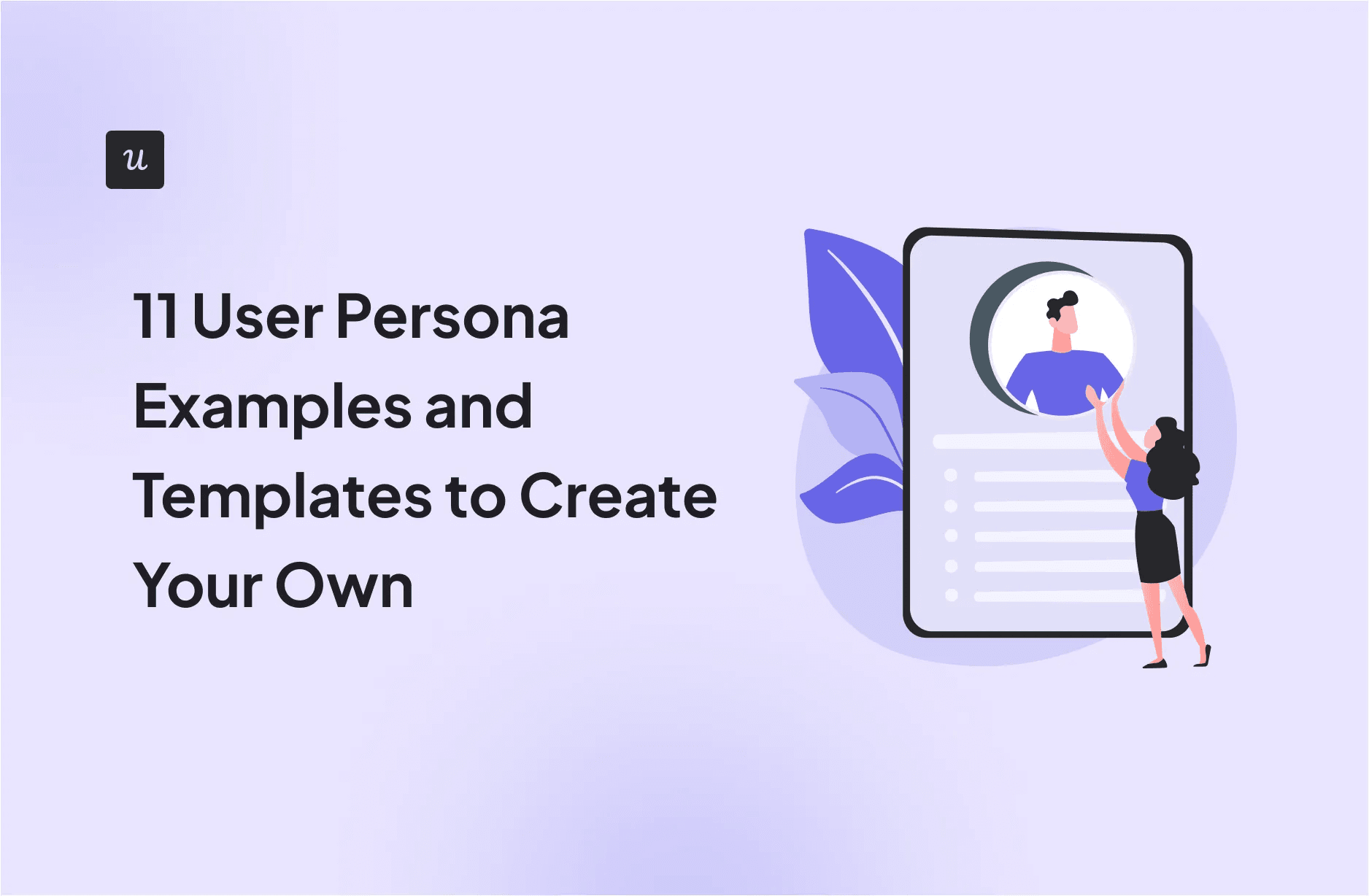
A user persona is a semi-fictional character representing a specific user segment or customer type who uses your product or service. User persona examples especially help product management and UX teams better understand customers by highlighting their needs, pain points, and key aspects of their journey.
These greater insights user personas offer also facilitate more informed product development and design decisions. If that’s something you’re interested in, this article will help, deep-diving into:
- User persona examples for inspiration.
- User persona templates to help you get started.
- How to write a user persona and other FAQs.
Try Userpilot Now
See Why 1,000+ Teams Choose Userpilot

6 User persona examples
Creating an effective user persona begins with extensive user research – which is tedious work. To ease the process, here are the six best customer persona examples to use as a guide.
These will help you understand what information to collect and prioritize for different persona types.
What’s your main goal with creating a user persona?
What kind of product are you working on?
What’s your biggest challenge with user personas right now?
Ready to build actionable personas that drive growth?
Userpilot can help you gather user data and create in-app experiences tailored to your key personas. See how it works with a personalized demo.
Target user persona example from Userpilot
Userpilot’s user persona example outlines information about the Product Marketing Manager who works at a B2B SaaS company with 11–50 employees.
Apart from these basics, the profile answers key questions such as:
- Who is your ideal user? Defines the specific customer type within your target audience who you want to buy your product, along with finer details about their collaborations.
- What is their main goal? The jobs-to-be-done (JTBDs) section explains why these customers use or want to use your product.
- What is their main challenge? Outlines customer pain points they’re looking to solve that keep them from getting their tasks done.
This information enables the creation of targeted marketing strategies and relevant product features that resonate with the customer type.
Pro tip: This example is a good building block. But user persona best practice suggests you focus on a single goal instead of multiple. This allows you to concentrate your efforts on resolving a specific issue before tackling the next one.

Typical user personas for Spotify
Spotify has different personas based on the key demographics and behavior patterns of various user segments that might use their app.
Here are some questions that such user personas help answer:
- How does the typical user behave? Lists down user behaviors and preferences. For instance, The Curator’s behavior of actively creating, modifying, and sharing themed playlists.
- What are their interests? Provides psychographic insights into user interests and lifestyle choices. For instance, The Nostalogic shows no interest in new music and only values the music he grew up with.
- What are their goals? Mentions the user’s main goals and needs as a direct consequence of their behaviors and interests from above.
- What are their frustrations? Highlights the problems customers face that hinder their user experience.
With these insights, you can boost feature adoption and upsells through targeted in-app communications and contextual prompts based on user behavior and needs.
Pro tip: Similar to the previous example, Spotify’s personas also focus on way too many goals and frustrations. This makes it hard to prioritize one objective.
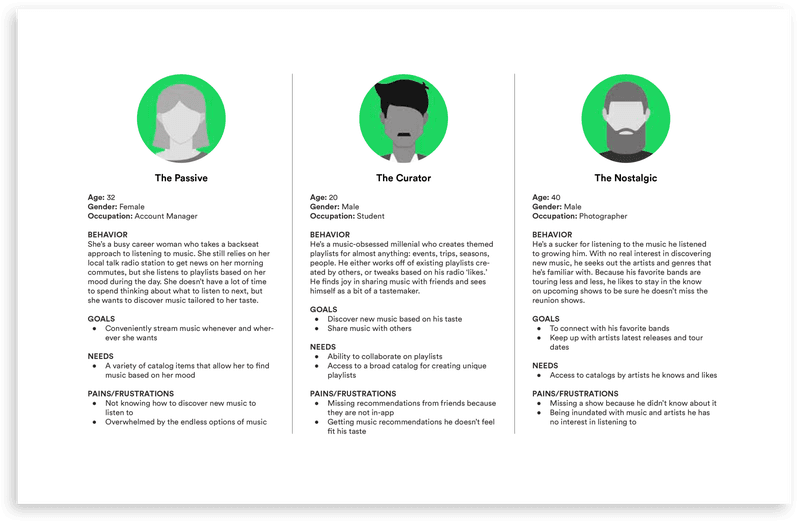
Ideal user personas for Canva
Based on user surveys, research, and interviews, Canva developed personas to represent its diverse user base. This includes information like:
- What is the user’s objective? States the user’s end goal to meet, which they’re considering or using your product.
- What motivates them? Includes psychographic information into customer values. For example, Claudia’s preference for “professional-looking designs.”
- What are their challenges? Highlights frustrations customers face both physically and mentally.
- What is their skill level? Outlines user’s technological skill levels along with the main device type they use.
The purpose of developing these personas is to better empathize with customers, so it becomes easier to design with their needs in mind. Additionally, the information on their technological skills helps with better segmentation and bridging the gap between the desktop and mobile experiences.
Pro tip: If there’s one best practice you take away from Canva’s example, it should be this: Talk directly to your users. There’s no substitute for the quality insights user interviews and surveys unlock.
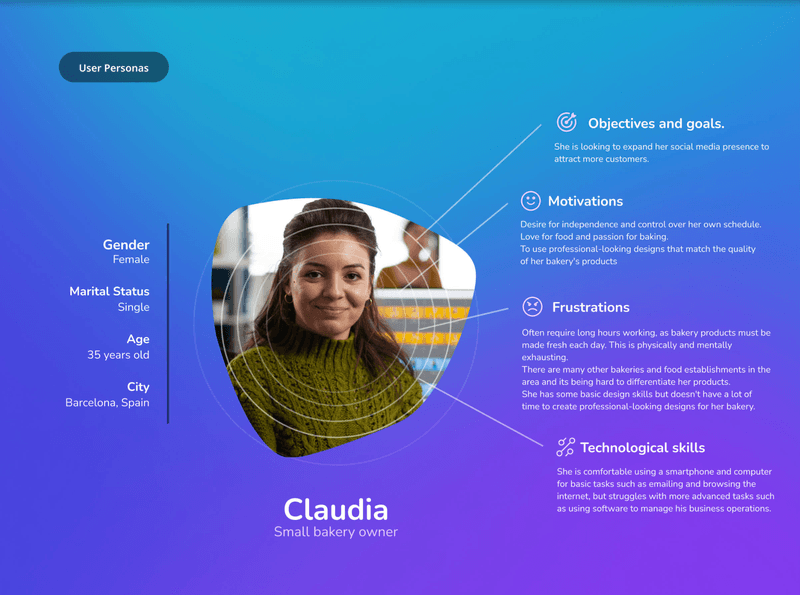
User personas for a traffic update application
This user persona example gathers details on regular commuters who heavily rely on navigation and traffic update apps but find them lacking in terms of accuracy. It clearly outlines the user’s goals and pain points, along with information on:
- What does the user behavior look like? Explains the user’s behavior, like their dependence, and daily routine on traffic apps.
- How comfortable are they with technology? Captures the user’s technological proficiency, like their tech-savviness.
All this collected data makes it easier to see how to provide immediate value to target customers through improved product development.
Pro tip: This example only focuses on demographics. Instead, best practice suggests going beyond demographics to include psychographic insights too. This improves user understanding by providing additional context into their motivations and aspirations.

Customer persona example for guiding design decisions
Apart from the user’s demographics, this customer persona provides more key information such as:
- Who is your ideal customer? Outlines customer behaviors, interests, and values the target user may have.
- What are their goals and challenges? Identifies the customers’ problems and objectives that they’re looking to fulfill with your product.
- What do they sound like? Helps marketing departments understand what tone, style, and language or jargon the target market might resonate with the most.
So far, all the persona examples we covered above revolved around SaaS products or services. However, personas can help refine the design process for physical products, too. That’s the main purpose of creating this persona.
Pro tip: The example does a good job of capturing what the ideal customer is like by including a quotation. This helps create engaging and highly relevant marketing campaigns with the right keywords.
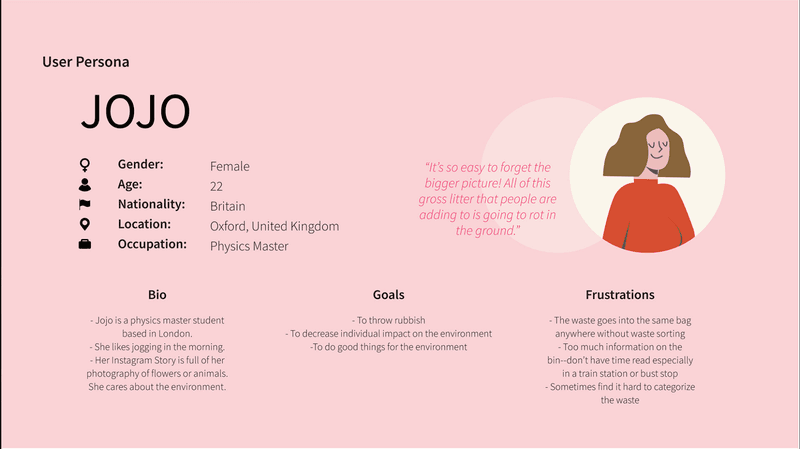
Target audience persona for user research purposes
Lastly, this user persona example helps discover critical details about your target market by answering questions like:
- Who is your ideal user? Summarizes information on user demographics, psychographics (lifestyle choices and interests), and behaviors.
- What is their technology adoption like? Explains the frequency of tech use, the level of integration into their lives, and the popular platforms visited.
- What are their goals and pain points? Lists numerous goals the user has, along with the many difficulties they face in achieving those goals.
- What do they sound like? Includes a quotation of what a target user’s problem statement might sound like.
This user research data is useful for improving segmentation, for instance, based on the level of digital adoption. These insights also improve empathy, encouraging designers and marketers to embrace a more customer-centric approach.
Pro tip: This example has the most challenges we’ve seen listed so far. Therefore, for better decision-making, you can use surveys to collect accurate data on which issue to prioritize.
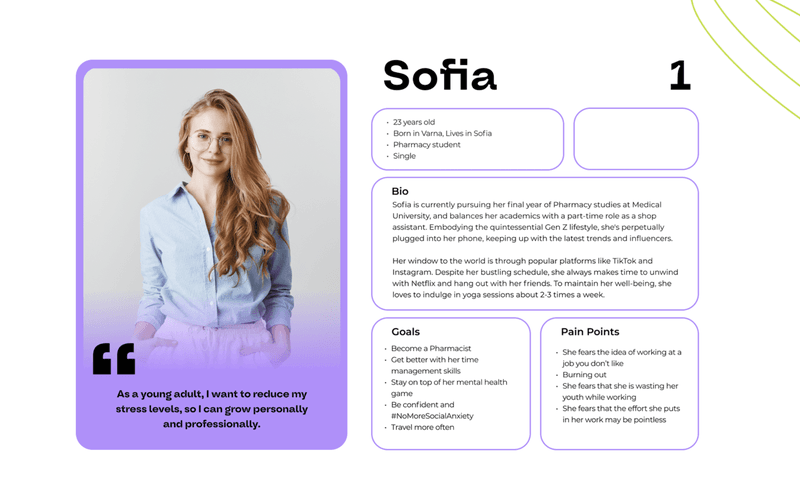
5 templates for creating user personas
Here are five (amazing) templates to help you develop detailed user personas that reflect the unique characteristics of your target users.
Buyer persona template from Venngage
This is a comprehensive buyer persona template that covers several important elements, such as:
- Demographics, including occupation, age, role, etc.
- Interests; the bio includes psychographic information about hobbies and more.
- Purchasing motivations, rated on a scale for easy prioritization.
- Personality traits, rated on a scale of relevant options, like Loyal vs Impulsive.
- Trusted brands that have won the customer’s loyalty.
- Multiple goals and frustrations, highlighting issues your product needs to solve.
- Quotation, for deeper customer insights into the persona’s personality.
This template is best suited for: Marketing and sales teams.
Specifically, the insights into the buyer’s preferred communication styles are incredibly useful for tailoring content strategies and sales campaigns.

Marketing persona template from Canva
Canva, the leader of customizable templates, provides a customer profile that’s ideal for developing a marketing persona. It helps capture the finer details beyond basic customer data, such as:
- Demographics, including previous work experiences.
- Psychographics, like interests and memorable characteristics.
- Business information, with multiple fields like current state, ideal state, motivations, success metrics, and more.
- Product experience insights, including needs satisfied by the product, any product problems, and desired developments.
This template is best suited for: Brand building efforts.
The extensive information the template captures is necessary for building stronger relationships with the right customer segment using the right message.
Figma’s template for creating detailed personas
This user persona template is useful for putting a face and name on a specific customer segment. Designed to gather information on what typical users will look like, it includes useful elements like:
- Personality traits, rated on a spectrum of relevant options, like Independent vs Team Player.
- Trusted brands that influence the user’s purchase decisions.
- Behavior traits, providing insights into user habits and decision-making processes.
- Goals and needs, explaining reasons to use your product or service.
- Customer pain points, explaining ways your product or service can help.
- Interests, collecting psychographic information that may influence the purchase decision.
This template is best suited for: Product development teams.
Such a detailed persona template is especially useful if you’re conducting a UX audit. This is because of all the in-depth insights it provides into multiple facets of the user experience, allowing for targeted improvements.

Miro’s user persona template for brainstorming sessions
Miro’s template doesn’t just collect information on personas. It also helps teams define the steps that come before and after persona creation. So, it only makes sense to discuss the template’s elements accordingly, which is divided into three sections.
Purpose:
- Mission explaining why you want to develop personas.
- Defining user research required for creating personas.
- Success criteria to gauge whether your personas are useful.
- Visual elements, like post-it notes, simulate an engaging brainstorming session.
User persona:
- Basic demographics, like what the user does, their location (context), and daily behaviors.
- Motivations, i.e., the reasons behind user decisions and choices.
- Goals and challenges outlining what users want and the barriers stopping them from it.
- Values, including information sources, referrals, or brands they trust.
Response:
- Further research, i.e., what information needs to be validated.
- Missing information you still don’t know.
- Plan of action, defining the next steps and any changes in your processes.
This template is best suited for: Cross-functional teams creating a lightweight persona.
Lightweight personas serve as initial building blocks for teams new to personas. They are created to help align all teams on a specific product strategy.
User persona template from Xtensio
Lastly, though a bit visually crude, Xtensio’s user persona template gets the job done, capturing all the crucial elements typically required. These include:
- Demographics, like age, job title, location, etc.
- Goals and frustrations, highlighting customer problems keeping them from achieving their aims.
- Quotation, for providing greater context and emotional depth to personas.
- Personality traits, rated on a customizable scale, like Thinking vs Feeling.
- Behavior trends offer insights into how users make decisions.
- Influencing factors that impact user decisions, like traditional ads or social media channels.
This template is best suited for: Marketing and design teams.
What sets this template apart is its addition of marketing channels as influencing factors. This makes it a highly effective template for marketing teams looking to create personalized messaging.

User persona examples FAQs
How to write persona bio UX?
Here’s everything to include in a UX persona bio:
- Name and demographics, especially occupation and role.
- Background, adding a brief personal history and relevant experiences.
- Behavioral traits, including habits, interests, and preferences.
- Frustrations with their current solution/product.
What are the 4 personas?
The four main types of user personas are:
- Proto persona: An idealized version based on secondary market research. Used for understanding target customer desires.
- Customer persona: A more realistic representation of your target customer. This persona includes information on customer needs, behaviors, and demographics.
- User persona: A fictional representation portraying typical users. It helps explore how users interact with a product.
- Buyer persona: A fictional character representing your target market. Buyer personas focus on the needs of both product users and purchasers.
What is an example of a user persona?
Here’s what a user persona example might look like:
- Name: Sarah, 28
- Role: Marketing Manager
- Goals: Increase brand awareness, streamline social media strategy.
- Frustrations: Limited time, difficulty analyzing data.
- Tech savvy: High; uses multiple analytics tools.
- Quote: “I need efficient ways to track and improve our campaigns.”
How to write a user persona?
- Collect data: Gather insights from interviews, surveys, and market research.
- Analyze data: Identify patterns and similarities among users.
- Create a user persona: Build distinct profiles with names and images.
- Add additional context: Include user interests, goals, and aspirations.
- Update regularly: Revise personas to reflect any changes in user behavior.
Conclusion
What’s the one thing all these user persona examples have in common? A deep understanding of the user’s goals and pain points.
All the additional categories, like interests or behaviors, are just the cherry on top. Before worrying about them, you need to perfect your basics. This means spending ample time on the first step of creating personas, which is user research.
Get that right and you’ll unlock valuable insights for informing product design and marketing decisions.
If you’re struggling with user research, Userpilot makes it easier, helping you collect user data with in-app surveys, behavioral analytics, and more. Book a demo today to see what it can do for you!


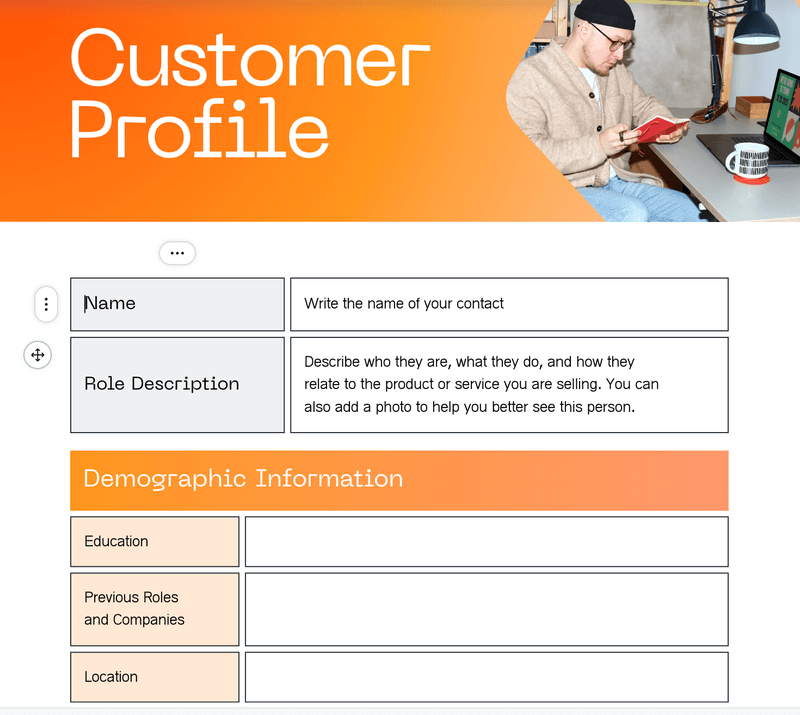
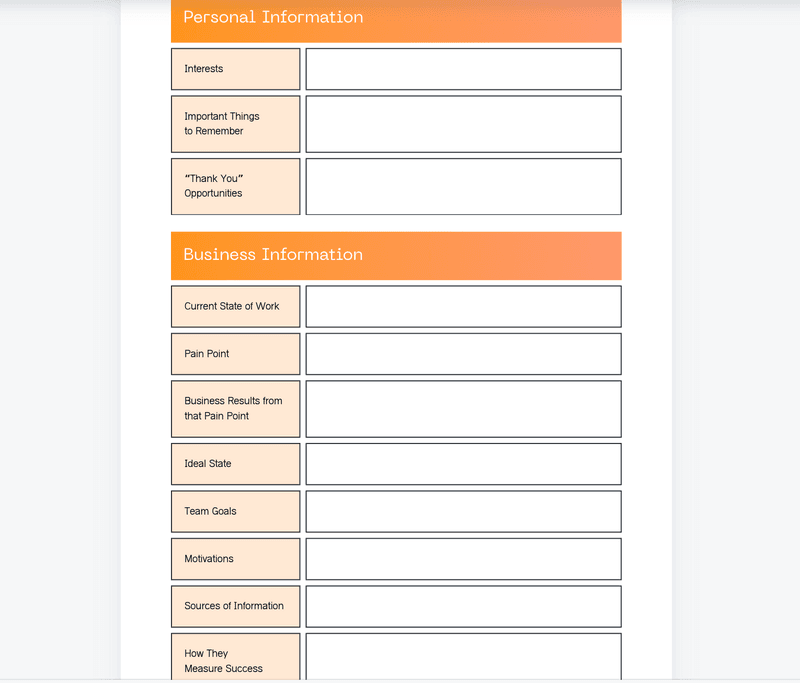

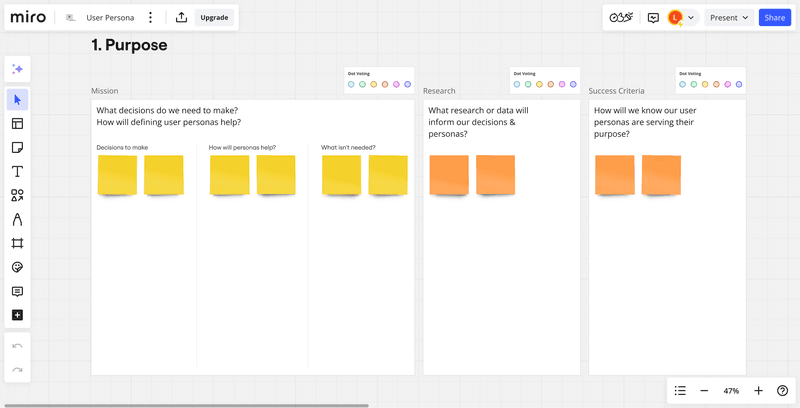

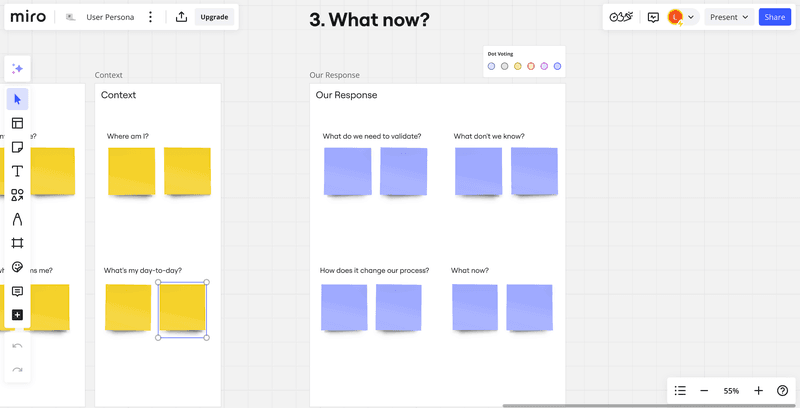

![10 Free Product Roadmap Templates You Need in 2026 [+Free Download] cover](https://blog-static.userpilot.com/blog/wp-content/uploads/2026/01/10-product-roadmap-templates-you-need-in-2026-free-download_d8269f0b0b9749f6ad7b519ab7ac1833_2000-1024x670.png)

